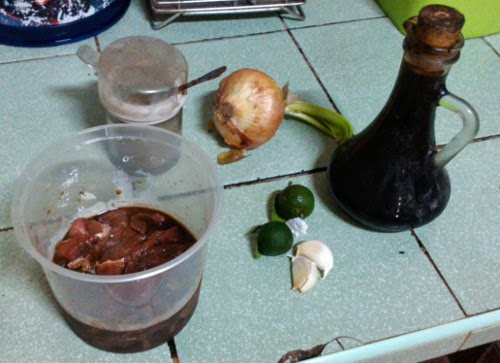In this series of posts, I’ll be discussing the different Filipino dishes that I’ve been cooking and experimenting on for quite some time now.
« You can find out more in the introductory post.
Past dishes:
« Dish #1: Giniling
Just two quick notes for all recipes:
- Most of them, when paired with rice, will serve 3-5 people.
- I will only show pictures of the ingredients. I’m leaving the “take a picture of the dish” to the foodies. Go to Google Image Search if you want pictures of the dishes.
—
Like Giniling, today’s recipe is so easy that a kid can make it. However, you do need to know “The One Weird Trick™” in cooking it.
—
Bistek

1/4 kg sirloin beef strips
1 medium white onion, cut crosswise (i.e. rings)
2 cloves garlic, chopped
calamansi
soy sauce
1/2 tsp ground pepper
Step 1: In a plastic container, marinate the beef with juice from 2-3 calamansi (use a stainer to remove the seeds), garlic, pepper, and soy sauce (1/4 cup? I just use enough to fully immerse the beef). Let the meat marinate for at least 30 minutes. I like mine marinated for more than 2 hours.
Step 2: Saute onions in oil in a pot. Again I prefer stainless steel.
Step 3: Put the meat (marinade included) in the pot along with around 1/2 cup of water and 2 tbsps soy sauce. Cover and simmer for at least 45 minutes. Stir at 10-15 minute intervals, adding a bit water when it gets too dry. Check done-ness by tearing apart a strip with a pair of forks. The meat should tear with little effort.
Season to taste before serving. We recommend adding more calamansi juice at the end for more bite. Oyster sauce can also be added to the simmering stew for the usual “body and flavor”.
As with Giniling, if you use too much soy sauce, you can try salvaging the dish with sugar.
—
Just like Giniling, Bistek is another common sight at turo-turo (eateries). It’s also called “Beef Steak” which is both wrong (when compared to the more popular American Steak) and technically right (when taking its Spanish roots) at the same time. Because of this, when you hear a Filipino mention “Pork Steak”, it’s probably not a literal pork steak, but pork chops cooked in the same fashion as Bistek
And by the same fashion, it just means “simmer marinated meat in soy sauce and calamansi juice for a long time”. For people not living in the tropics, you can try to replace calamansi with any other lime-related fruit (not lemon or orange) but I haven’t tried it myself.
The long cooking time is “The One Weird Trick™”: meat goes through the following phases when you cook it:
- Soft, tender, and juicy because it’s undercooked (e.g. like a medium rare steak)
- Tough and dry because it’s overcooked (e.g. overcooked steak)
- Tender and juicy because the collagen has broken down (e.g. stewed/braised/slowcooked meat)
- Dry and stringy (overstewed/overbraised meat)
Unfortunately, many people are not aware of the information above and think that their tough, jerky-like Bistek is a problem with prepping the meat e.g. “we should’ve tenderized it with a mallet” or “we should’ve marinated it longer”.
Repeating it again to drill it into your head, if you want tender bistek, you have to simmer the meat for a long time. The 45 minutes is enough since we’re using strips. For thicker cuts, you’ll have to wait for a future recipe that deals with that.
—
Bonus recipe:
I do this variation if I want to waste time. The only things it does to the final product are (1) make the onions look more presentable i.e. not soggy rings and (2) add a bit more flavor via the Mallard reaction.
We do this by separating the sauteed the onions and frying the meat like Tapa before stewing.
Bistek, the hard way
Same ingredients as above
Step 1: Same as step 1 above, but do not include garlic and pepper as they will burn in the searing process.
Step 2: Saute onions in oil and set aside. To save cleaning, you can do this in the pot that you would use for the next step.
Step 3: Add a bit more oil to the pot and sear the meat (set aside the marinade). You can do this strip by strip or as a whole batch. Since it’s marinated, the meat will give off a lot of liquid and the browning process isn’t as simple as a steak. You can let the juice boil off (just like frying sausages) or you can drain it into the marinade container and add a bit of oil to continue the frying process.
Step 4: Once the strips look like fried Tapa (lol), add the marinade and the rest of the ingredients (sans onions) and continue from step 3 onwards. Upon serving, top the dish with the sauteed onion rings.
—
Next recipe: Tinola »


